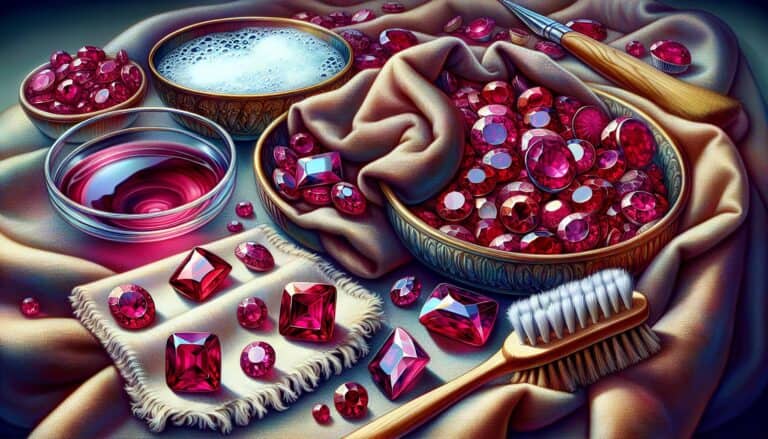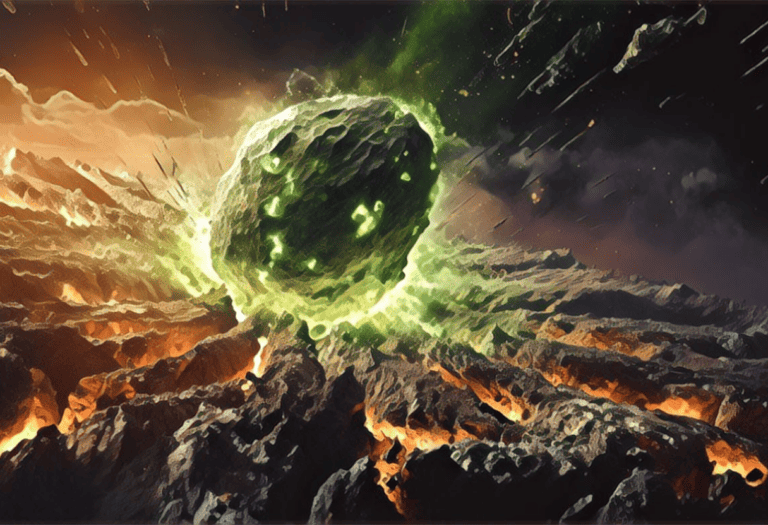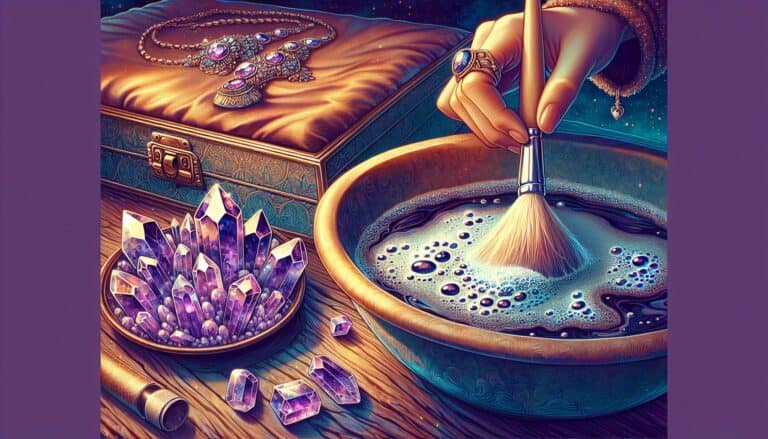Ever stumbled upon a crystal clear gem and wondered if it’s the elusive danburite? You’re not alone!
Danburite, with its diamond-like luster, often flies under the radar but is a treasure to gem enthusiasts. It’s known for its clarity and durability, making it a fantastic choice for jewelry.
Identifying danburite can be tricky, but you’re in luck. With a few insider tips, you’ll be spotting this hidden gem like a pro. Whether you’re a collector or just curious, getting to know danburite’s unique characteristics is a rewarding venture.
Let’s dive into what sets danburite apart from the crowd.
To identify danburite, look for clear to white elongated crystals with wedge-shaped terminations, a white streak, and a Mohs hardness of 7-7.5. Danburite is not magnetic, exhibits significant birefringence, and has a refractive index of 1.627-1.641. It’s commonly found in association with calcite and quartz.
How to Identify Danburite Through Testing
When you’re trying to determine if a gemstone is danburite, tests are key. Below, you’ll find a range of methods that you can use to positively identify this gemstone.
Visual Inspection
Firstly, look at the stone’s clarity and color. Danburite typically has a clear to white color but can appear yellowish or pinkish in some cases. Its crystal form is usually elongated with wedge-shaped terminations. If the stone you’re examining exhibits these characteristics, you may be holding danburite.
The Streak Test
Take a piece of unglazed porcelain and scratch the stone across it. Danburite leaves a white streak. Remember, this method can damage softer gemstones, so use it with caution.
Magnet Test
Danburite is not magnetic, so if your stone is attracted to a magnet, it’s likely not danburite. This simple test can quickly eliminate many other minerals.
Hardness Test
You can perform a hardness test by trying to scratch the surface with a substance of known hardness. Danburite has a hardness of 7 to 7.5 on the Mohs scale, so it can scratch glass and metals like copper but not as easily as diamonds.
Birefringence Test
Danburite exhibits significant birefringence. When viewed under a polariscope, you should see a doubling of the back facets if the stone is unmounted.
Checking The Diaphaneity
Examine how light passes through the stone. Danburite’s diaphaneity ranges from transparent to translucent, another hint towards identification.
Single or Double Refraction
Using a refractometer, you can determine if the stone is singly or doubly refractive. Danburite is doubly refractive, an important diagnostic feature that separates it from look-alikes such as quartz.
Refractive Index Test
This test requires specialized equipment. A refractometer can help you measure the refractive index of the stone, which for danburite, lies between 1.627 and 1.641.
| Property | Danburite |
|---|---|
| Refractive Index | 1.627 – 1.641 |
Finding The Specific Gravity
The specific gravity of danburite ranges between 2.93 and 3.02. Weighing the stone in air and then in water can give you the necessary data to calculate its specific gravity.
| Property | Danburite |
|---|---|
| Specific Gravity | 2.93 – 3.02 |
Identifying Danburites in the Field
If you’re in a known danburite locality, look for the unique elongated crystal habit and lack of cleavage which is typical for danburite. Well-formed prismatic crystals are a good indicator of this gem.
Recognizing Potential Danburite Rocks
In the field, danburite can often be found in association with certain other minerals like calcite and quartz. If you come across igneous or metamorphic rocks with these minerals, it may be worth investigating for danburite.
Physical Characteristics of Danburite

When you’re on the hunt for danburite, you should be keenly aware of its unique physical characteristics. Knowing these will significantly enhance your ability to discern danburite from similar gemstones. First off, danburite crystals are typically colorless to light pink; however, they can also come in shades of yellow or brown. You’ll find that the clarity of these crystals is often quite high, which is why danburite is sometimes mistaken for other more precious gems like diamonds.
These crystals commonly form in an elongated prismatic shape with linear striations running parallel to the length of the crystal. It’s also not uncommon to encounter danburite with chisel-shaped terminations. When inspecting the crystal form, look for the characteristic wedge-like terminations which are a tell-tale sign you’ve stumbled upon danburite.
In terms of luster, danburite tends to exhibit a glassy or vitreous shine, making it quite attractive when cut and polished for jewelry. But let’s dig into the more measureable aspects; danburite has a hardness of 7 to 7.5 on the Mohs scale, which means it’s relatively scratch-resistant. Considering its hardness, be mindful when performing a hardness test to avoid damaging any potential jewelry stones.
Lastly, the specific gravity of danburite falls within the range of 2.9 to 3.0. This specific gravity is higher than that of quartz but lower than the likes of diamond. Use this parameter to further narrow down your identification process. Remember, paying close attention to these physical traits will provide invaluable clues when differentiating danburite from other minerals in the field.
How Are Danburite Formed?
Danburite crystals are formed under high temperature and pressure conditions deep within the Earth’s crust. This process takes place primarily in regions with a history of intense geological activity, such as volcanic areas or places with a concentration of hot springs. The formation of danburite is associated with metamorphic and igneous processes, and can often be the result of contact between these two geological phenomena.
Your understanding of danburite’s origins is crucial when you’re out in the field. Hydrothermal activity primarily influences the growth of these crystals. Subterranean fluids enriched with silicate minerals are the catalyst for danburite formation. Over extensive periods, these fluids cool and crystalize to form the distinct prismatic danburite crystals you recognize.
Another key element in danburite formation is the presence of boron. Boron is a critical component that stabilizes the structure of the crystal as it forms. Because of its unique crystallization process, danburite is often found in association with minerals like quartz, calcite, and sphalerite. These associations are telltale signs that can lead you to discover danburite deposits during your field inspections.
Understanding the formation of danburite gives you a valuable perspective on why it appears alongside certain minerals and how this information can be leveraged in its identification. Remember, the conditions under which danburite forms can vary, resulting in a range of physical properties that you’ll use to distinguish it from other gemstones.
Preparation for Danburite Hunting
Before you embark on your adventure to find danburite, it’s crucial to go prepared. Being equipped with the right tools and knowledge will not only make your hunt more successful but also safer and more enjoyable.
Gathering the Right Tools
To identify danburite effectively, you’ll need to carry a specific set of tools. Ensure you have these essentials:
- Hand lens or jeweler’s loupe: A magnifying tool is indispensable for examining the clarity and crystal form of potential danburite samples.
- Geologist’s hammer and chisel: These are crucial for extracting samples from larger rock formations.
- Field notebook and pen: Keep detailed records of your findings, including location and characteristics of the stones.
- Streak plate: A porcelain tile to help you perform streak tests.
- Digital scale: To measure the specific gravity of the samples you collect.
- UV light: Some danburite stones may fluoresce under UV light, making this a useful tool for identification.
- Safety goggles and gloves: Protection is key when dealing with rough materials and tools.
By having these items, you’ll be well-prepared to identify genuine danburite specimens. Remember to pack your tools securely and in an organized manner to facilitate easy access during your hunt.
Safety Considerations
Your safety should be your top priority. Here’s what you need to keep in mind:
- Wear protective clothing: Durable boots, long pants, and long-sleeved shirts will protect you from scrapes and cuts.
- Inform someone of your plans: Always let someone know where you’re going and when you expect to return.
- Check the weather: Be aware of the weather conditions and plan your trip accordingly to avoid being caught in dangerous situations.
- Stay hydrated: Bring enough water to last the duration of your trip, especially if you’re heading to remote locations.
- First-aid kit: Accidents can happen, so it’s essential to carry a basic first-aid kit for minor injuries.
- Regional research: Understand the wildlife and potential hazards of the area you’re exploring to stay prepared for any encounters.
With your tools in check and safety measures in place, you’re primed to start your danburite hunting trip. Remember that responsible hunting also means respecting the natural environment and any regulations of the area you are exploring. Keep an eye on the terrain and potential danburite deposits as you utilize these preparations to guide your search.
Handling and Care of Found Danburite

When you’ve successfully identified your danburite specimen, it’s crucial to handle and care for it properly. This ensures that your gemstone remains in the best condition for evaluation, sale, or personal collection.
Cleaning and Storing Danburites
Cleaning your danburite is the first step in its care. Over time, dirt and oils from your skin can adhere to the stone, affecting its luster and clarity. Here’s how to do it safely:
- Use a soft, lint-free cloth to gently wipe the stone.
- If more thorough cleaning is needed, immerse it in warm soapy water and use a soft brush to reach crevices.
- Rinse thoroughly with cool water to remove any soap residues.
- Dry with another clean, soft cloth.
Be mindful that although danburite has a hardness of 7 to 7.5 on the Mohs scale, it can still be scratched by harder materials. Avoid using harsh chemicals or abrasive methods that might damage your gemstone.
Storing danburite requires attention to prevent accidental damage.
- Wrap your cleaned danburite in a soft cloth or place it inside a fabric-lined jewelry box individually.
- If you’re placing multiple stones in one container, ensure they are separated to avoid scratches.
- Store in a cool, dry place away from direct sunlight to prevent color fading or structural damage.
By following these steps, you’ll maintain the pristine condition of your danburite, retaining its value and beauty. Remember to periodically inspect your stored danburites to ensure they remain free from damage and are not exposed to adverse conditions that could affect their integrity.
Conclusion: Confirming Danburite is Real
You’ve now got the know-how to identify danburite with confidence.
Remember, the key is in the details—from visual inspection to hands-on tests. With this knowledge, you’re well-equipped to discern danburite’s unique characteristics and ensure that your gemstone finds are authentic. Caring for your danburite is just as important; proper cleaning and storage will preserve its beauty for years to come.
Trust in your newfound skills and enjoy the beauty and satisfaction that comes with discovering and maintaining these hidden treasures.







